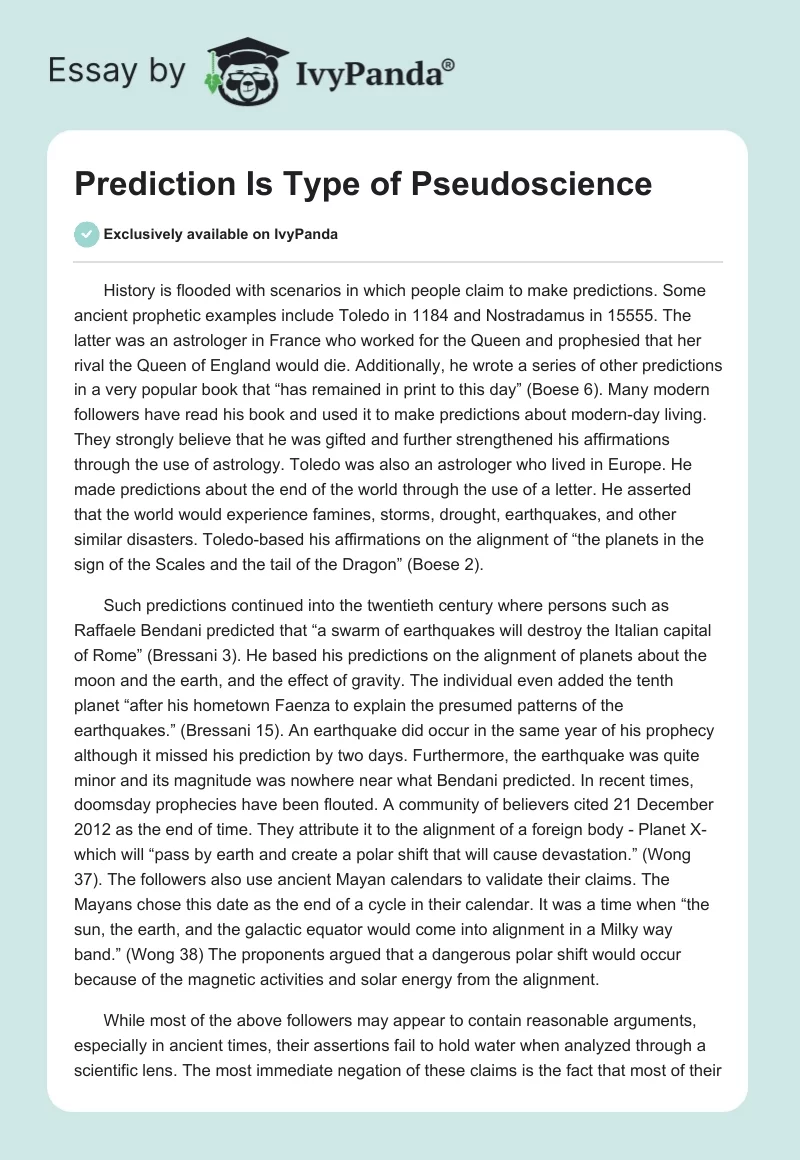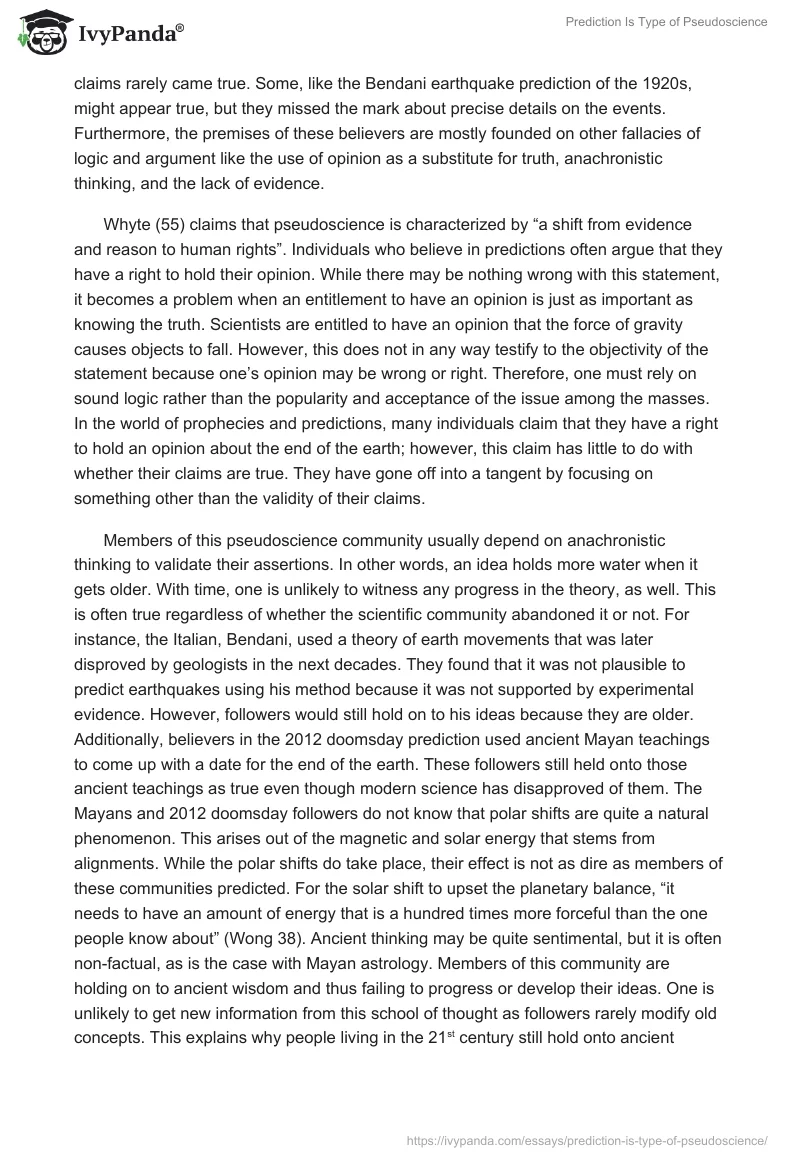History is flooded with scenarios in which people claim to make predictions. Some ancient prophetic examples include Toledo in 1184 and Nostradamus in 15555. The latter was an astrologer in France who worked for the Queen and prophesied that her rival the Queen of England would die. Additionally, he wrote a series of other predictions in a very popular book that “has remained in print to this day” (Boese 6). Many modern followers have read his book and used it to make predictions about modern-day living. They strongly believe that he was gifted and further strengthened his affirmations through the use of astrology. Toledo was also an astrologer who lived in Europe. He made predictions about the end of the world through the use of a letter. He asserted that the world would experience famines, storms, drought, earthquakes, and other similar disasters. Toledo-based his affirmations on the alignment of “the planets in the sign of the Scales and the tail of the Dragon” (Boese 2).
Such predictions continued into the twentieth century where persons such as Raffaele Bendani predicted that “a swarm of earthquakes will destroy the Italian capital of Rome” (Bressani 3). He based his predictions on the alignment of planets about the moon and the earth, and the effect of gravity. The individual even added the tenth planet “after his hometown Faenza to explain the presumed patterns of the earthquakes.” (Bressani 15). An earthquake did occur in the same year of his prophecy although it missed his prediction by two days. Furthermore, the earthquake was quite minor and its magnitude was nowhere near what Bendani predicted. In recent times, doomsday prophecies have been flouted. A community of believers cited 21 December 2012 as the end of time. They attribute it to the alignment of a foreign body – Planet X- which will “pass by earth and create a polar shift that will cause devastation.” (Wong 37). The followers also use ancient Mayan calendars to validate their claims. The Mayans chose this date as the end of a cycle in their calendar. It was a time when “the sun, the earth, and the galactic equator would come into alignment in a Milky way band.” (Wong 38) The proponents argued that a dangerous polar shift would occur because of the magnetic activities and solar energy from the alignment.
While most of the above followers may appear to contain reasonable arguments, especially in ancient times, their assertions fail to hold water when analyzed through a scientific lens. The most immediate negation of these claims is the fact that most of their claims rarely came true. Some, like the Bendani earthquake prediction of the 1920s, might appear true, but they missed the mark about precise details on the events. Furthermore, the premises of these believers are mostly founded on other fallacies of logic and argument like the use of opinion as a substitute for truth, anachronistic thinking, and the lack of evidence.
Whyte (55) claims that pseudoscience is characterized by “a shift from evidence and reason to human rights”. Individuals who believe in predictions often argue that they have a right to hold their opinion. While there may be nothing wrong with this statement, it becomes a problem when an entitlement to have an opinion is just as important as knowing the truth. Scientists are entitled to have an opinion that the force of gravity causes objects to fall. However, this does not in any way testify to the objectivity of the statement because one’s opinion may be wrong or right. Therefore, one must rely on sound logic rather than the popularity and acceptance of the issue among the masses. In the world of prophecies and predictions, many individuals claim that they have a right to hold an opinion about the end of the earth; however, this claim has little to do with whether their claims are true. They have gone off into a tangent by focusing on something other than the validity of their claims.
Members of this pseudoscience community usually depend on anachronistic thinking to validate their assertions. In other words, an idea holds more water when it gets older. With time, one is unlikely to witness any progress in the theory, as well. This is often true regardless of whether the scientific community abandoned it or not. For instance, the Italian, Bendani, used a theory of earth movements that was later disproved by geologists in the next decades. They found that it was not plausible to predict earthquakes using his method because it was not supported by experimental evidence. However, followers would still hold on to his ideas because they are older. Additionally, believers in the 2012 doomsday prediction used ancient Mayan teachings to come up with a date for the end of the earth. These followers still held onto those ancient teachings as true even though modern science has disapproved of them. The Mayans and 2012 doomsday followers do not know that polar shifts are quite a natural phenomenon. This arises out of the magnetic and solar energy that stems from alignments. While the polar shifts do take place, their effect is not as dire as members of these communities predicted. For the solar shift to upset the planetary balance, “it needs to have an amount of energy that is a hundred times more forceful than the one people know about” (Wong 38). Ancient thinking may be quite sentimental, but it is often non-factual, as is the case with Mayan astrology. Members of this community are holding on to ancient wisdom and thus failing to progress or develop their ideas. One is unlikely to get new information from this school of thought as followers rarely modify old concepts. This explains why people living in the 21st century still hold onto ancient beliefs about the Mayans. “When something does not develop or progress, then its falsifiability is often illuminated” (Carroll 9).
Prophets, astrologers, and other individuals who make predictions often do so from “a point of ignorance” (Coker 14). They are not willing to subject their assertions to the rigors of scientific research, yet they make their claims based on partial information. Science has methodologies and procedures that can be used to refute many claims made about the future. All that one requires is a simple and well-constructed experience to establish whether the assertion is true or not. Wong (38) explains that “The planet X is twenty times the size of Jupiter and it would be easy to observe in the sky with the naked eye”. Therefore, astronomical evidence firmly disputes this theory amongst its followers. If the prophets were committed to the truth, then they would let their opponents subject their theories to rigorous testing to validate their affirmations. When a claim lacks information, then it is not possible to verify it. This means that those who claim to support it are evading the truth. When believers in prophetic predictions are asked whether they have considered the possibility of certain information, many of them will argue that science cannot prove or understand their affirmations. However, in most instances, scientists refrain from topics about the end times because minimal evidence exists to support the phenomenon. Those who can demonstrate that evidence exists to disprove the pseudo scientist’s theory will often be ignored. For instance, when the 2012 doomsday adherents used the polar shift as a basis for their prediction, they did so from a point of ignorance. They should have done a lot more research on the effects of polar shifts in modern times. They should also have known that Albert Einstein supported the theory of the Hapgood polar shift to explain this spinning of the Earth. It had no dire consequences at the time and would not do so under any foreseeable circumstances. Those prophets used “only partial truth to propagate their claims” (Braithwaite 15).
Prophets and other predictors of events use astronomic alignments and other similar phenomena to validate their claims. However, these assertions are usually done from a point of ignorance. Many of them do not research the facts around the assertions and are unwilling to get tested. They also use anachronistic thinking by giving ancient assertions more weight than new findings, so progress is never made. Lastly, they use their right to hold an opinion as a substitute for thinking.
References
Boese, Alex. 2011. Pseudoscience hoaxes. 2011. Web.
Braithwaite, Jill. Critical thinking, logic, and reason, a practical guide for students and academics. Birmingham: Birmingham University Press, 2006. Print.
Bressani, David. 2011. Pseudoscience and prophecy of earthquakes.2011. Web.
Carroll, Rota. The skeptic’s dictionary. New Jersey: John Wiley, 2003. Print.
Coker, Rory. 2011. Earmarks of pseudoscience. 2011. Web.
Whyte, Jay. Crimes against logic. New York: McGraw-Hill, 2005. Print.
Wong, Katrina 2011, Science, and pseudoscience behind the 2012 doomsday prophecy. 2013.


